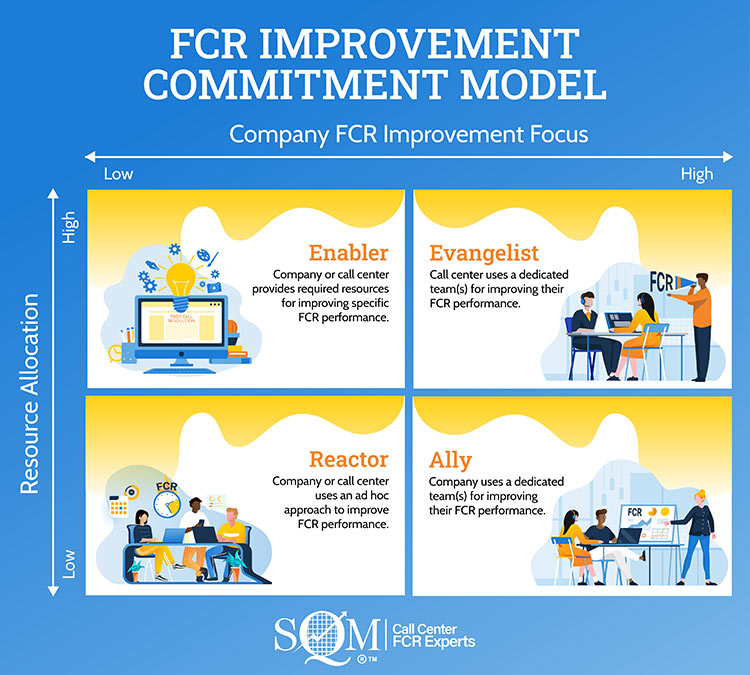Why is FCR Important?
At SQM Group, we are often asked, "Why is First Call Resolution important?" First Call Resolution KPI is the KING of all call center metrics because measuring it and improving it helps reduce operating costs and customers at risk of defection, improves employee and customer satisfaction, increases selling opportunities, and the Net Promoter Score®.

The effects of First Call Resolution (FCR) on business profits cannot be overstated. FCR metric provides excellent insights into customer service, cost, retention, referrals, and opportunities to increase First Call Resolution.
SQM Group's research shows that the average FCR rate is 70% for the call center industry, which means 30% of customers have to call back the contact center to resolve their initial call reason. When we examined the source of errors (SoE) for non-FCR calls, we discovered that the customer was the SoE 13% of the time, an agent was the SoE 38% of the time, and the organization (e.g., out of the control of the call center) was the highest SoE at 49% of the time.
FCR Improvement Commitment Model
For non-FCR calls, 49% of the time, it is an organizational SoE issue out of the control of the call center business practices. Given the high organizational non-FCR SoE issues, call center leaders must partner with other departments outside the call center function to improve FCR and customer experience (CX).
To help call centers improve CX, we have developed an FCR Improvement Commitment Model that call centers can use to improve FCR. This model is based on two dimensions (i.e., resource allocation requirement and the company FCR improvement focus requirement) for improving CX performance.
The combination of the two dimensions helps describe the four quadrants illustrated:
Enabler (high resource allocation and low FCR focus),
Reactor (low resource allocation and low FCR focus),
Ally (low resource allocation and high FCR focus) and
Evangelist (high resource allocation and high FCR focus).
There is no single best practice within the FCR Improvement Commitment Model as all four practices can effectively improve FCR. Determining which FCR improvement commitment practice is appropriate for the call center will depend on the call center's FCR performance.

Resource allocation and company FCR improvement focus dimensions are used because they are critical to the operating practices needed for an organization that wants to improve its FCR performance. These quadrants offer different approaches to improve the organization's FCR performance and are used by SQM clients. Enabler and Reactor are the most commonly used practices for SQM clients to improve FCR performance for both the company and the call center.
For the FCR Improvement Commitment Model, the term "company" implies (i.e., people, processes, and technology) practices that are outside of the control of the call center. On the other hand, the term "call center" implies (i.e., people, processes, and technology) practices inside the call center's control.
The following describes each quadrant shown in the above figure:

Call centers that use the Enabler practice to improve FCR have a high commitment towards resource allocation and a low commitment to focusing on FCR performance over the long term. The Enabler practice can fix people, processes, and technology issues that are hindering FCR performance.
The Enabler practice is strategic (e.g., certain call types, policies, and procedures) and is proactive towards improving FCR. Of the four different FCR improvement commitment practices, the Enabler practice is the second most commonly used. Additionally, 15% of SQM clients use this practice, and their FCR performance can range anywhere between the first and fourth quartiles.
Resource allocation is project-based and is temporary. In most cases, resource allocation for improving FCR is 1 to 12 months. As a result, call centers that use the Enabler practice for FCR improvement tend not to focus on improving FCR performance continually.
The Enabler practice focuses on processes and technology because the issues are more complex and take longer to improve. In addition, processes and technology issues tend to cross over to departments outside the call center. For example, the Enabler practice works on billing, claims, products, and services. The Enabler practice works best to improve FCR initiatives when the organization and/or call center senior leadership has a clear line of sight that the required high resource allocation commitment will improve FCR, operating costs, and customer service.

Call centers that use the Reactor practice for improving FCR have a low commitment towards resource allocation and a low commitment to focusing on FCR performance over the long term. Reactors tend to focus on fixing people practices to improve FCR performance because they are less complex and easier to fix. However, reactors will also fix processes and technology practices where a quick win is possible.
The Reactor practice is essentially a reactive approach to fixing a problem that is hindering FCR. A quick win might be to change something in the people, processes, or technology practices that would not require a significant investment to implement. For example, the call center management team wants to improve the recognition program by recognizing Agent Csat survey rating performance.
Of the four different FCR improvement commitment practices, the Reactor practice is the most commonly used. 70% of SQM clients use this practice, and their FCR performance can range between the first and fourth quartiles. The Reactor practice is used often due to the low resource allocation and FCR focus commitment required. Resource allocation for improving FCR is project-based, temporary, and, in most cases, lasts 90 days or less. As a result, organization and/or call center senior leadership are more willing to take a chance on FCR improvement initiatives because of the low commitment required.

Call centers that use the Ally practice to improve FCR have a low commitment towards resource allocation and a high commitment to focusing on FCR performance on an ongoing basis. The Ally practice can focus on fixing people, processes, and technology methods to improve FCR performance.
For the Ally practice to work well, the senior leaders at the organization level must value and understand the benefits of improving FCR performance on the organization and the call center. Of the four different FCR improvement commitment practices, the Ally practice is the least commonly used. However, 5% of SQM clients use this practice, and their FCR performance can range anywhere between the first and fourth quartiles.
The Ally practice is the least used because of the shared services component and the perception that these employees are not as committed to improving FCR because they do not work in the call center. However, the value that shared service employees bring to the call center is their knowledge of how other organizational departments operate and the potential opportunities to fix those organizational issues hindering the call center's FCR performance.
The Ally practice works on quick wins (i.e., people); however, it focuses on long-term (i.e., processes and technology) FCR improvement initiatives requiring low resource allocation. The organization's senior leadership is committed to using a dedicated team for improving FCR performance on an ongoing basis.
The FCR improvement team can be comprised of call center and organizational employees. In some cases, the FCR improvement team may comprise only corporate employees from a shared service structure (e.g., research, Six Sigma team, human resources, training, marketing, and IT). As a result, resource allocation tends to be limited because it is coming from shared services.

Call centers that choose to use the Evangelist practice for improving FCR have a high commitment towards resource allocation and a high commitment towards focusing on FCR performance on an ongoing basis. In addition, the Evangelist practice can focus on fixing people, processes, and technology methods to improve FCR performance.
The Evangelist practice can work on quick wins (i.e., people) and long-term (i.e., process and technology) FCR improvement initiatives requiring high resource allocation. The call center's senior leadership is committed to using a dedicated team to improve FCR performance on an ongoing basis.
Of the four different FCR improvement commitment practices, the Evangelist practice is the third most commonly used. 10% of SQM clients use the Evangelist practice, and their FCR performance is either in the first or fourth quartile. In other words, call centers that use the Evangelist practice are very polarized in that they can be either the best or the worst FCR performing call centers in North America.
This polarization is because if the call center is a first quartile FCR performer, they want to maintain or improve their quality and cost. But, conversely, when the call center is a fourth quartile FCR performer, they recognize their poor FCR performance and are highly motivated to improve their quality and cost.
A small but growing number of organizations have included the FCR metric for enterprise-wide accountability at all levels (e.g., CEO and down). Therefore, using the FCR metric to create employee accountability at all levels can help ensure the evangelist approach for achieving excellent execution, especially when you consider that the real opportunities to improve FCR and CX come from organizational SoE issues.
Dedicated Teams
Both the Ally and Evangelist practices use a dedicated team to focus on FCR improvement initiatives. The dedicated team typically comprises an FCR Champion (e.g., project lead), call center employees, and shared services employees (e.g., process improvement specialists - Six Sigma, IDCA). This team can have as few as five people or be as many as 25 people.
The Ally team is usually comprised of shared services employees and is the much smaller team, and the Evangelist team is the much larger team. In addition, Ally and Evangelist teams bring in subject matter experts (SMEs) from the organization (e.g., billing, claims, and technical) and from the call center (e.g., Agents, analysts, and supervisors) to assist them in identifying, developing and implementing FCR improvement initiatives.
Quick Related Links
First Call Resolution Definition First Call Resolution PPT First Call Resolution Benefits
First Call Resolution Strategies First Call Resolution Operating Philosophy FCR Case Study Survey Data Calculate First Call Resolution Rate Five Benefits of Journey Mapping CX Pulse Check VoC Closed-Loop Top 10 CX Metrics FCR Strategy Options Outside-In or Inside-Out Journey Mapping
